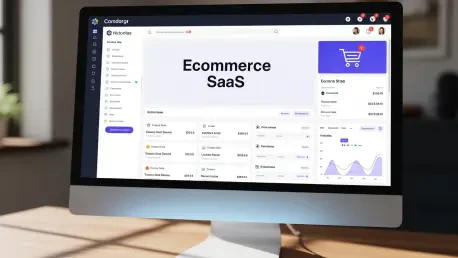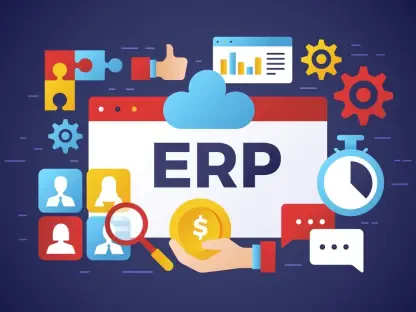Setting the Stage for Digital Commerce Evolution
The global e-commerce landscape is experiencing an unprecedented boom, with online retail sales projected to surpass trillions of dollars annually, creating a dynamic environment for businesses. Amid this surge, companies face the daunting challenge of establishing a robust online presence without sinking resources into complex technical infrastructure. Ecommerce SaaS (Software as a Service) platforms have emerged as a game-changer, offering a streamlined solution that allows companies to launch and scale digital stores with remarkable ease. These platforms are reshaping how startups, small retailers, and even large enterprises approach online selling. This review delves into the capabilities, trends, and real-world impact of these tools, providing a thorough assessment of their role in modern commerce.
Defining the Core of Ecommerce SaaS Technology
Ecommerce SaaS platforms are subscription-based software solutions designed to empower businesses to create and manage online stores without requiring extensive technical expertise. Unlike traditional models where companies own and maintain their own software or infrastructure, SaaS operates as a managed service. This means hosting, updates, security, and support are handled by the provider, freeing businesses from the burden of backend complexities and allowing them to focus on core operations like sales and customer engagement.
The significance of these platforms lies in their ability to democratize access to e-commerce tools. From fledgling entrepreneurs to established corporations, SaaS solutions cater to a wide audience by offering scalability and simplicity. Their subscription model ensures predictable costs, while the cloud-based nature guarantees accessibility from anywhere, making them a vital asset in today’s fast-paced digital economy.
Key Features Driving Performance and Usability
Intuitive Design and Customization Options
One of the standout aspects of Ecommerce SaaS platforms is their user-friendly approach to store design. Most offer drag-and-drop interfaces and a variety of pre-built templates, enabling users to set up visually appealing storefronts without any coding knowledge. This accessibility ensures that even those with minimal design experience can create professional-grade online shops in a matter of hours.
For businesses seeking a more distinctive look, many platforms provide options for deeper customization. Advanced users can leverage scripting capabilities or opt for professional design services to align the store’s aesthetics with unique branding goals. This balance of simplicity and flexibility makes SaaS an attractive choice for a diverse range of business needs.
Robust Integrations for Operational Efficiency
Another critical strength of these platforms is their seamless integration with essential business tools. Built-in connections to payment gateways, shipping logistics, and marketing solutions like SEO optimization and social media advertising streamline day-to-day operations. Such features reduce the need for manual intervention, allowing businesses to focus on growth rather than administrative tasks.
Additionally, many SaaS providers offer open APIs, which facilitate automation and connectivity with external systems such as CRM software or inventory management tools. This interoperability enhances workflow efficiency, ensuring that businesses can adapt to changing demands without overhauling their existing setups. The result is a cohesive ecosystem that supports end-to-end e-commerce functionality.
Emerging Trends and Innovations in the SaaS Space
The Ecommerce SaaS market is evolving rapidly, driven by technological advancements that cater to shifting consumer expectations. Mobile optimization stands out as a key focus, with platforms prioritizing responsive designs to capture the growing number of shoppers using smartphones. This trend reflects the need for seamless experiences across devices, ensuring businesses don’t lose potential sales due to poor mobile interfaces.
Beyond mobile, AI-driven personalization is transforming how online stores engage customers. Features like tailored product recommendations and predictive analytics help businesses understand and anticipate consumer behavior, boosting conversion rates. Furthermore, the rise of omnichannel selling and multi-currency support highlights the industry’s move toward global accessibility, enabling retailers to tap into international markets with ease.
Practical Applications Across Diverse Industries
Ecommerce SaaS platforms demonstrate remarkable versatility, serving a wide array of sectors with tailored solutions. Small retail startups often turn to tools like Shopify, which excels in supporting dropshipping models with its intuitive setup and extensive app marketplace. Meanwhile, BigCommerce appeals to businesses prioritizing SEO, offering advanced tools to enhance online visibility and drive organic traffic.
For larger enterprises, solutions like Salesforce Commerce Cloud provide enterprise-grade capabilities, focusing on omnichannel strategies that integrate physical and digital sales channels. On the other end of the spectrum, platforms such as Wix eCommerce cater to creative small businesses with design-centric features, while Ecwid offers lightweight integration for adding e-commerce to existing websites. These varied use cases underscore the adaptability of SaaS technology in meeting specific business objectives.
Navigating Challenges and Limitations
Despite their many advantages, Ecommerce SaaS platforms come with certain drawbacks that businesses must consider. A primary concern is the limited ownership and customization compared to open-source alternatives like WordPress. Since the platform is managed by the provider, users often face restrictions on modifying core functionalities, which can be a hurdle for those requiring highly bespoke solutions.
Dependency on subscription fees and provider policies also poses potential risks. Businesses may find themselves locked into pricing structures or terms that limit long-term control over their online presence. However, many SaaS providers are addressing these issues by expanding feature sets and offering custom development options, aiming to balance ease of use with greater flexibility for users.
Projecting the Future Trajectory of SaaS Solutions
Looking ahead, the Ecommerce SaaS market shows immense promise, with projections estimating growth to $29.82 billion by 2032. This expansion is likely to be fueled by deeper integration of AI technologies, enhancing personalized shopping experiences through sophisticated data analysis. Mobile-first strategies are also expected to intensify, ensuring platforms cater to the ever-growing base of mobile shoppers.
The long-term impact on retail could be profound, as SaaS continues to lower barriers to entry for new players. This democratization of e-commerce tools may reshape competitive dynamics, enabling smaller businesses to challenge established brands. As innovation accelerates, these platforms are poised to redefine how digital commerce evolves over the coming years.
Reflecting on the Impact and Next Steps
Having explored the multifaceted world of Ecommerce SaaS platforms, it is evident that their ease of use, scalability, and cost predictability offer substantial value to businesses. Their ability to simplify complex processes while providing managed services stands out as a defining strength, though trade-offs in control and customization remain a noted limitation. The real-world applications and ongoing innovations further highlight their transformative role in digital retail.
Moving forward, businesses are encouraged to carefully evaluate their specific needs when selecting a platform, ensuring alignment with strategic goals such as global expansion or niche branding. Partnering with experienced developers can also amplify success, tailoring solutions to maximize potential. As the SaaS landscape continues to evolve, staying informed about emerging features and integrations proves essential for maintaining a competitive edge in the dynamic world of online commerce.









